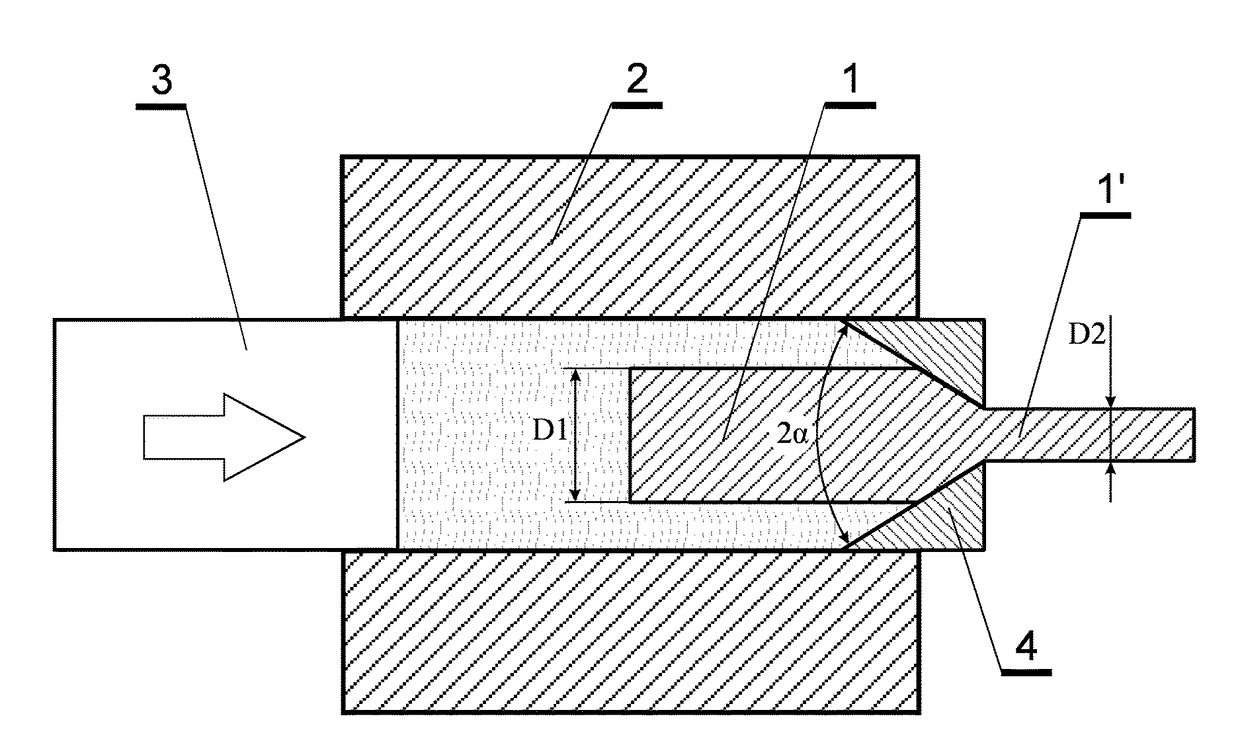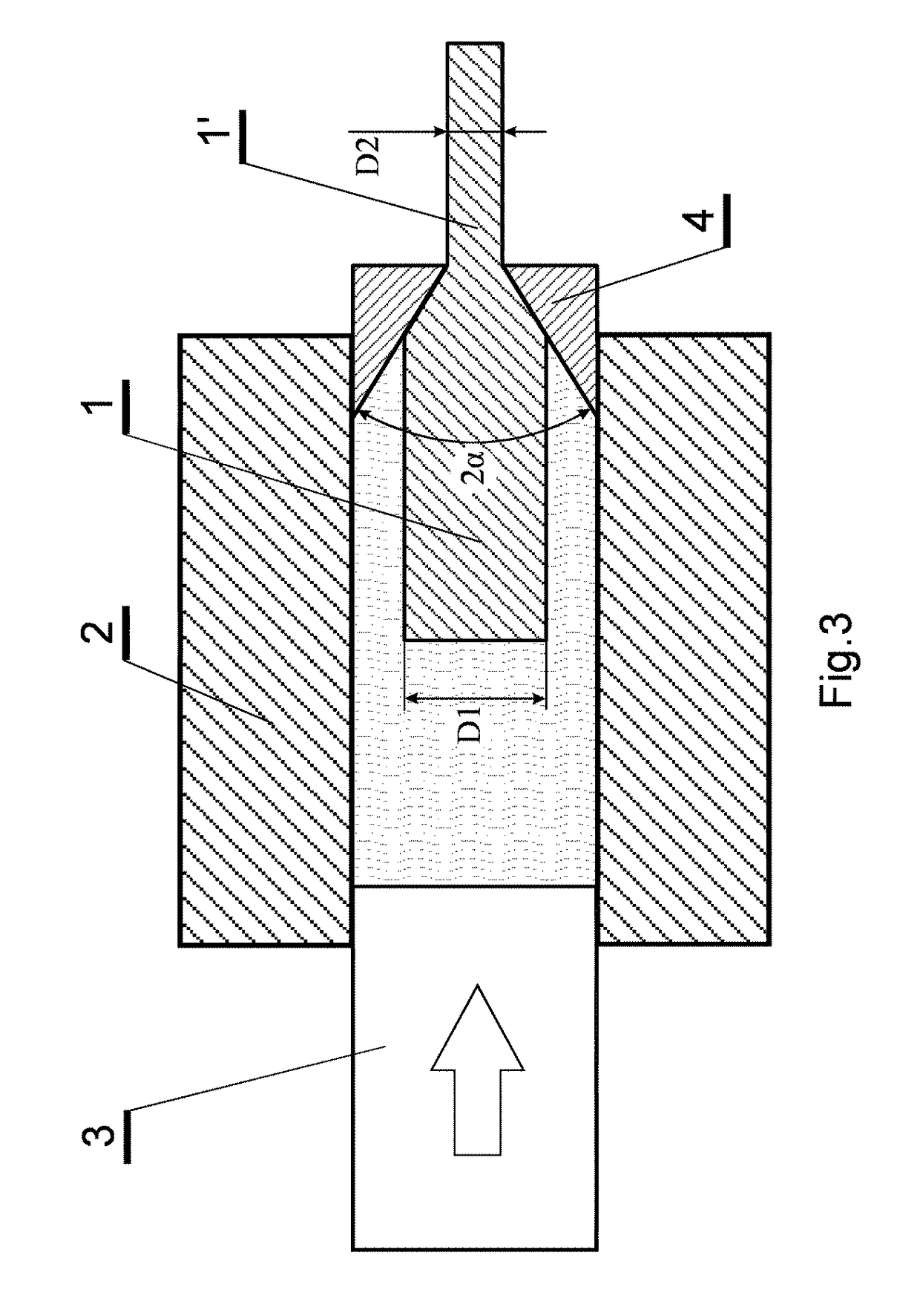Method of fabrication of nanocrystalline titanium, in particular for medical implants, and titanium medical implant
a nano-crystalline titanium and titanium technology, applied in the field of nano-crystalline titanium fabrication, can solve the problems of unsatisfactory industrial applications quality of wire surface, low mechanical strength, and inability to meet the needs of medical devices, so as to reduce the number of necessary operations, reduce the wear of tools and other equipment, and reduce the effect of process duration
- Summary
- Abstract
- Description
- Claims
- Application Information
AI Technical Summary
Benefits of technology
Problems solved by technology
Method used
Image
Examples
example 1
Rod with a Diameter of 5 mm Made of Nanocrystalline Titanium
[0016]A rod containing above 99 wt % of pure coarse-grained titanium Grade 2 according to the ASTM Standard (American Standard for Testing and Materials) No B-348-09 was used for preparing the hydrostatic extrusion billet 1 in the form of a cylinder with the diameter D1=50 mm and length of 300 mm which at one side was ended with a cone with an apex angle of 43°. The billet was covered with a friction-reducing agent, which was an aluminum coating 10 μm thick, deposited on the titanium by magnetron sputtering, and, then, additionally covered with a wax layer. The thus prepared billet 1 was placed in the working chamber 2 of the extrusion apparatus and the chamber was closed with the piston 3. The cone-shaped end of the billet 1 was inserted into the conical hollow of the die 4. As a result of the movement of the piston 3 deep into the chamber 2, the pressure of the pressure transmitting medium increases and the billet 1 is ex...
example 2
Rod of Nanocrystalline Titanium with a Diameter of 5 mm
[0017]The titanium billet used in this example was the billet as in Example 1 but the aluminum coating deposited on it had a thickness of 15 μm. The billet was subjected to four consecutive hydrostatic extrusion passes through the die 4 with the apex angle 2α=45°. Just as in Example 1, the initial temperature of the billet did not exceed 50° C. During each of the three initial passes, the reductions R of the transverse cross-section surface area of the billet 1 were as in Example 1, whereas in the final fourth hydrostatic extrusion pass it was 2.1. The titanium rod obtained after this final pass had the diameter D2=6.1 mm i.e. the total reduction of the transverse cross-section surface area of the billet 1 was 67.2. The extrusion process was conducted so that the extrusion velocity did not exceed 10 cm / s. After each pass the product 1′ extruded from the die was cooled with cold tap water. Prior to each extrusion pass was covered...
example 3
Rod Made of Nanocrystalline Titanium with a Diameter of 3 mm
[0018]The titanium billet 1 as in Example 2 was subjected to five consecutive hydrostatic extrusion passes through dies with the apex angles 2α=45°. As in Examples 1 and 2 the initial temperature of the billet 1 did not exceed 50° C. In the initial four extrusion passes, the reduction R of the transverse cross-section surface area of the billet 1 was the same as in Example 1 whereas in the final (fifth) extrusion pass it was 2.34. The titanium rod obtained after this final extrusion pass had the diameter D2=4.16 mm i.e. the total reduction R of its transverse cross-section surface area was 144.5. The hydrostatic extrusion process was conducted so that the extrusion velocity did not exceed 23 cm / s and, after each extrusion pass the product 1′ extruded from the die 4 was cooled with cold tap water. Prior to each extrusion pass the billet 1 was covered with a wax layer. In order to improve the geometric feature (smoothness and...
PUM
| Property | Measurement | Unit |
|---|---|---|
| velocity | aaaaa | aaaaa |
| temperature | aaaaa | aaaaa |
| velocity | aaaaa | aaaaa |
Abstract
Description
Claims
Application Information
 Login to View More
Login to View More - R&D
- Intellectual Property
- Life Sciences
- Materials
- Tech Scout
- Unparalleled Data Quality
- Higher Quality Content
- 60% Fewer Hallucinations
Browse by: Latest US Patents, China's latest patents, Technical Efficacy Thesaurus, Application Domain, Technology Topic, Popular Technical Reports.
© 2025 PatSnap. All rights reserved.Legal|Privacy policy|Modern Slavery Act Transparency Statement|Sitemap|About US| Contact US: help@patsnap.com



